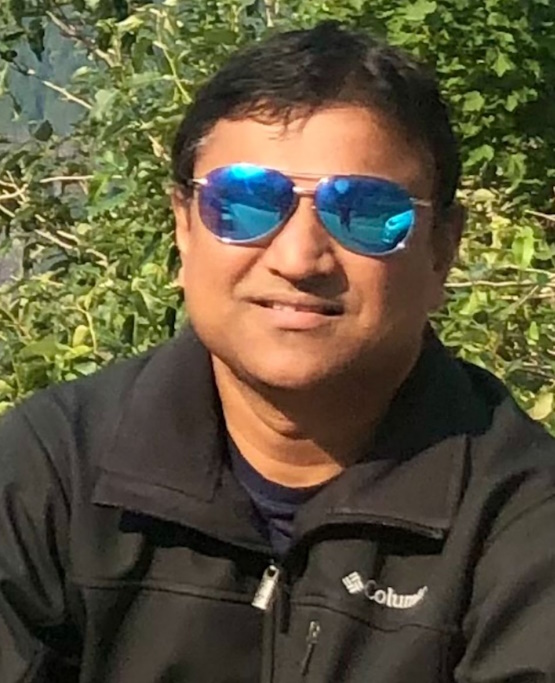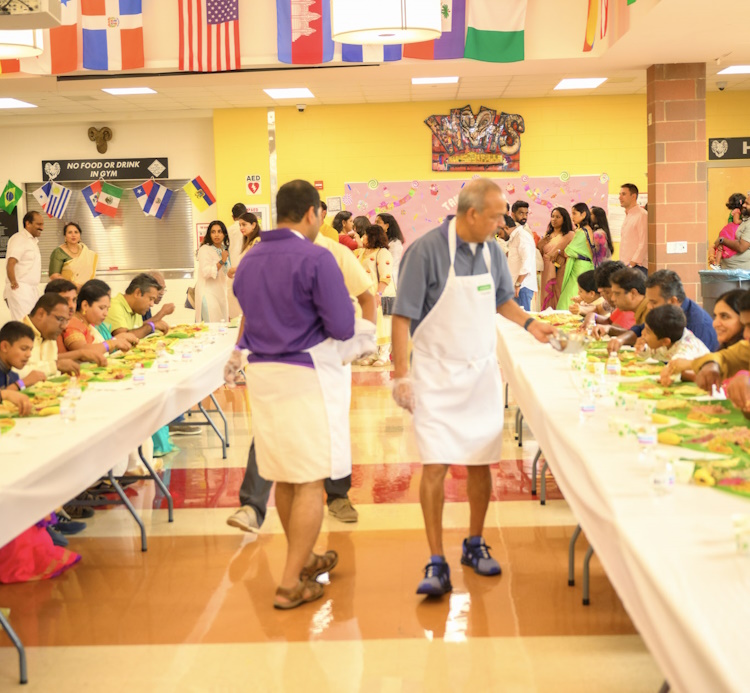
It was wonderful to meet so many of you in person at the COMA Onam celebrations. COMA Onam 2024 was a beautiful homage to our Malayalee traditions. From the colorful Pookkalam and delicious Sadhya to the cultural programs that included Thiruvathira and Mohiniyattam, the event showcased the richness of our culture. Every year, I am truly amazed and humbled by the dedication of our volunteers working tirelessly to make the Onam celebrations a success – their efforts remind us of the importance of togetherness and create a renewed sense of connection among the patrons.
My heartfelt gratitude goes to the 2024 COMA Executive Committee and all the volunteers for orchestrating yet another memorable event for all of us. A shout out also to the performers for keeping us entertained.
Media Links
- Official Onam photos by Rahul RP and Rakesh Vijayakrishnan
- Audience candids by Stephen Vattappara John
- Official videos by Pramod Pudhiyattil
— Smitha Nishant

Behind the scenes of the 2024 COMA Onam Sadhya – Subin Thomas
(Subin lives in Powell, Ohio with his wife Simple and two kids, Kevin and Trisha. Subin enjoys music and outdoor activities.)
Onam, one of the most significant and widely celebrated festivals in Kerala is also the most anticipated event in our community. Every year it brings together hundreds of Malayalees, fostering a sense of belonging and joy. Though the event is marked by various traditional activities and cultural programs, the grand attraction is the Onam Sadhya.
This year, like most previous years, I had the privilege of volunteering at the Onam Sadhya for approximately 600 people. Organizing and serving a traditional Onam Sadhya for the multitude was both a challenging and rewarding experience. It required meticulous planning, seamless coordination, and teamwork to deliver a satisfying meal to such a large group. The preparations began days in advance. From organizing to coordinating volunteers, every step had to be planned with precision.
We met the previous day so that we could chart out the table layout and seating arrangement, clean the tables and chairs, clean and store the paper banana leaves, organize utensils, glasses, napkins, and wipes, arrange the water station, as well as work with the EC and decor teams for any other requests.
The Sadhya volunteers were divided into two teams: a serving team and a refill team.

The sheer number of people meant that food refills had to be immediate, and ensuring that no dish ran out before everyone had been served was a constant concern. But another major challenge was ensuring that the entire Sadhya wrapped up by 2 PM so that the cultural programs could start on time, particularly because the venue had curfews.
With the time constraint in mind, we had to be extremely efficient with the serving process. The serving and refill teams needed to coordinate perfectly to ensure that every guest was served promptly, without rushing through the experience or compromising the quality of service.
The actual day of the Sadhya was a whirlwind of activities. We started by unloading food trays from the truck early in the morning, ensuring that every dish was transferred into the serving containers and stationed at the right spot. It was vital to keep track of all 15-20 dishes traditionally served during Sadhya, making sure everything from the Avial to the Payasam was ready on time.
Serving began at 11:30 AM as soon as the guests were seated. The serving team moved swiftly, placing clean banana leaves in front of each guest, following the traditional order of serving – starting with pickles, banana chips, and progressing through the vegetable dishes, rice, and curries. It required careful coordination, as we couldn’t afford any gaps in service, especially with such a large crowd.

It was fascinating to see how well the team functioned under pressure. Everyone knew their station, whether it was refilling rice or serving sambar, and the flow of service remained steady. Communication was key – we had team leaders overseeing different sections of the venue, ensuring smooth coordination between the kitchen and serving areas. Though the team worked under pressure, we didn’t forget to have the occasional fun by sharing banana chips, having a cup of payasam, cracking jokes, etc.
One of the most fulfilling aspects of this experience was seeing the joy on people’s faces. There is something incredibly rewarding about being part of such a traditional and significant cultural event. As we served each dish, folks would smile, offer their thanks, and often engage in conversation, creating a sense of community that made all the hard work worthwhile.

Being part of the Sadhya team and serving a Sadhya at this massive scale taught me invaluable lessons in teamwork, coordination, and adaptability. It has also deepened my appreciation for the cultural significance of the Sadhya, as it is not just a meal, but an experience that embodies tradition, hospitality, and togetherness.
The process of serving a Sadhya is not just about the food; it’s about bringing people together and creating a shared experience. It was heartwarming to see families, friends, and even strangers seated together, enjoying the meal, and celebrating the spirit of Onam.

My Experience at the COMA Onam Festival – Devika Rajan
(Devika is an 8th grader at Liberty Middle School. Her hobbies include reading, singing, and playing the flute. She performed dance at the Onam festival this year. She is the daughter of Mauja and Dr. Rajesh Rajan.)
Attending the COMA Onam event was a beautiful journey into my culture and reinforced my understanding of what Onam represents. As soon as I arrived, I was greeted by the stunning Pookalam that decorated the entrance. The vibrant colors and intricate designs reminded me of the Pookalam my mom used to create at our front door.
One of my favorite parts of the celebration was the Onam Sadhya. The spread was incredible, featuring an array of delicious sides paired with rice. I enjoy the annual tradition of feasting on a banana leaf.
The event also showcased Kerala’s rich cultural heritage. The introductory performance highlighted various traditional art forms including Theyyam which was new to me. I was thrilled to watch, especially since my mother was part of this performance. My brother also had his first performance this Onam which made it even more special. In addition, everyone attending wore beautiful traditional attire, which added to the festive atmosphere.
Another highlight of Onam was the entry of the Maveli, which was celebrated by everyone in attendance. The entry of Maveli was nice to watch as it was accompanied by the lively sound of Chenda and Pulikali.
Performing at COMA was an unforgettable experience for me and my friend Gauri. After countless hours of practice, stepping onto the stage felt exhilarating. Sharing our dance with the audience and receiving their applause made all the hard work worthwhile.

Overall, the COMA Onam event was an enriching experience that allowed me to celebrate my culture in a meaningful way. It reminded me of the importance of traditions and the joy they bring to our lives. I enjoy all COMA celebrations as they allow for me to gather with all my friends and have a great time.

COMA volunteering from a youth perspective – Adithya Menon
(Adithya Menon is a senior at Olentangy Liberty High School. In his free time, he likes to be active by going on hikes, playing basketball with friends, and working out. He is the son of Deepa and Jay Menon.)
Being part of the COMA Youth Wing has been an amazing experience. As a volunteer, I’ve participated in many community activities, like helping with the super fun Onam celebrations. Serving the traditional Sadhya meal was a blast because being part of such an important cultural event felt great. I also helped with registration, making sure everyone got their wristbands and checked in without a hitch.
But that’s not all! We’ve been busy planning cool events and programs for adults and kids. One exciting event coming up is a community hike on October 12th. It’s a perfect way to bring everyone together and enjoy some time outdoors. Getting involved in planning these activities has been awesome for my leadership skills and has taught me a lot about what goes on behind the scenes of running an event.

What’s been cool is working with people who are all about making a difference in our community. It’s been great for learning the ins and outs of organizing events.
Oh, and did I mention? You also earn service hours for all the time you put into helping out through this program. Overall, my time with the COMA Youth Wing has been super rewarding. I’ve grown as a leader and gotten more involved in my community. I wish many more youth would get involved as it’s a great way to have fun and community bonding, and I can’t wait to see what’s next!

The Joy and Challenges of Organizing Onam Sadhya in Columbus, Ohio – Sachinlal Sugathan
(Sachin is a COMA Onam Food Committee volunteer. He has been an active member of COMA from 2011, and lives with his wife Preeti and daughter Sahasra in Galena, Ohio.)
For the past 12 years, I have had the privilege of serving on the food committee for the Central Ohio Malayalee Association (COMA) during our annual Onam celebrations. Every year, we work hard to bring the traditional Onam sadhya to our community – a feast that evokes memories of home, heritage, and the unity of Malayalees. However, organizing a Sadhya in a city like Columbus, Ohio, comes with its unique set of challenges, which we have experienced firsthand.
The Complexity of Onam Sadhya
The Onam Sadhya is no ordinary meal. It is an elaborate spread of over 25 different curries and side dishes, each representing the cultural richness of Kerala. What makes it even more challenging is that every region of Kerala has its own variations of these curries. For instance, a simple Avial, Kootucurry, or Erissery can taste vastly different depending on whether it’s made by someone from one part of Kerala versus another region. This means that satisfying the expectations of one person can easily disappoint another. Finding a middle ground that appeals to the diverse palates of our Malayalee community is an intricate balancing act.
Limitations in Columbus
In larger cities with a significant Malayalee population, organizing a massive feast is somewhat more manageable. However, in a city like Columbus, the situation is quite different. None of the local restaurants have kitchens or utensils large enough to accommodate the volume of food required for a traditional Onam Sadhya. As a result, they are forced to cook in batches, often starting as early as midnight the day before. This can compromise the freshness of the food, sometimes leading to one or two dishes spoiling by the time they are served. Keeping over 25 dishes fresh and consistent over such a long period is no easy task. On top of that, the logistics of transporting all these dishes from the restaurant to the event venue adds another layer of complexity.
How Bigger Malayalee Organizations Tackle These Challenges
I’ve had the chance to connect with Malayalees from major regions in states like New York, Georgia, and Florida, and it’s evident that they manage the Sadhya logistics more smoothly, thanks to their greater resources. Many large Malayalee organizations in these cities have invested in custom-made utensils, burners, and even giant pots designed specifically for cooking and serving the Kerala Sadhya. These items are stored in dedicated storage units year-round, ready to be used during festivals like Onam.
Some organizations even go as far as flying in chefs from Kerala or other states to ensure that the Sadhya tastes as authentic as possible. These chefs, with their expertise, make the preparation of the meal smoother and closer to how it is traditionally done in Kerala. The key difference, of course, is the financial backing that these larger organizations enjoy. With significant sponsorships and donations pouring in annually, they have the budget to tackle such logistical challenges with ease. In comparison, COMA operates with more limited resources, making it all the more difficult to deliver a flawless Sadhya.
A Labor of Love
Despite these challenges, I have seen the incredible dedication and teamwork within COMA’s food committee. Our volunteers and local chefs go above and beyond to make the Onam Sadhya experience as memorable and authentic as possible. Every year, we should reflect on our experiences, adapt, and grow, motivated by our collective love for our culture and the passion to bring a taste of Kerala to our close-knit community in Columbus.

While we may not have the large-scale resources of bigger cities, our passion and commitment to delivering a traditional Sadhya, complete with all its complexities, are what truly set us apart. With continued support from the community, we can continue to make our Onam celebrations a cherished event for all.
In the end, organizing the Onam Sadhya is a labor of love – one that brings us closer together as a community and reminds us of the beautiful traditions we hold dear.
Disclaimer: Vocabulary enhanced using generative AI.

Both Sachin and Subin captured challenges with Onam Sadhya well!! I can say for sure Sadhya, be it organizing or serving, is improving every year.
Mainstay of the Onam Sadhya is the invaluable help from volunteers!! Hope more and more will come out and help in the future.
Thanks for the write ups that gave an insight about the behind-the-scenes planning of the Onam Sadya. Any limitations and criticisms of the Sadya are not aimed at the EC or the volunteers. Though it’s important that the Sadya contractors be aware of any negative feedback so they can improve next time.